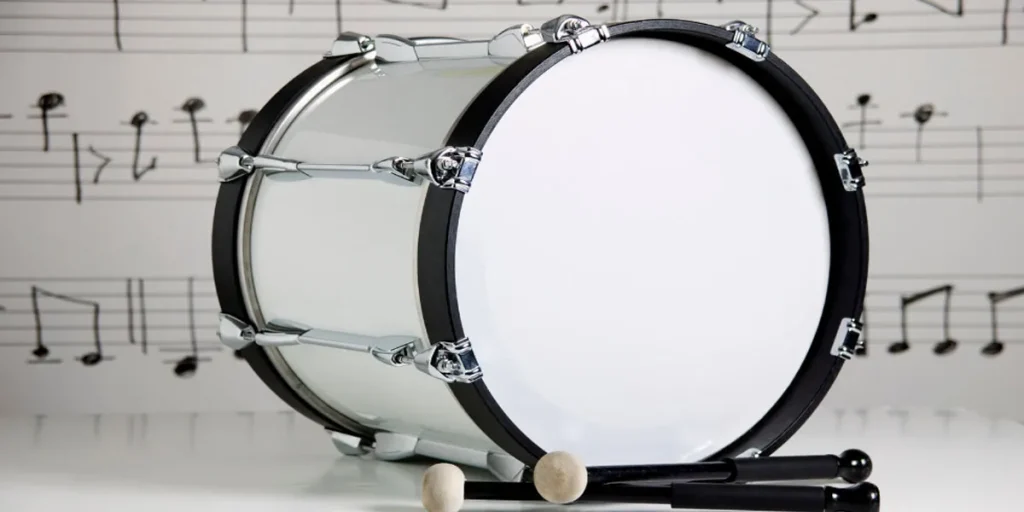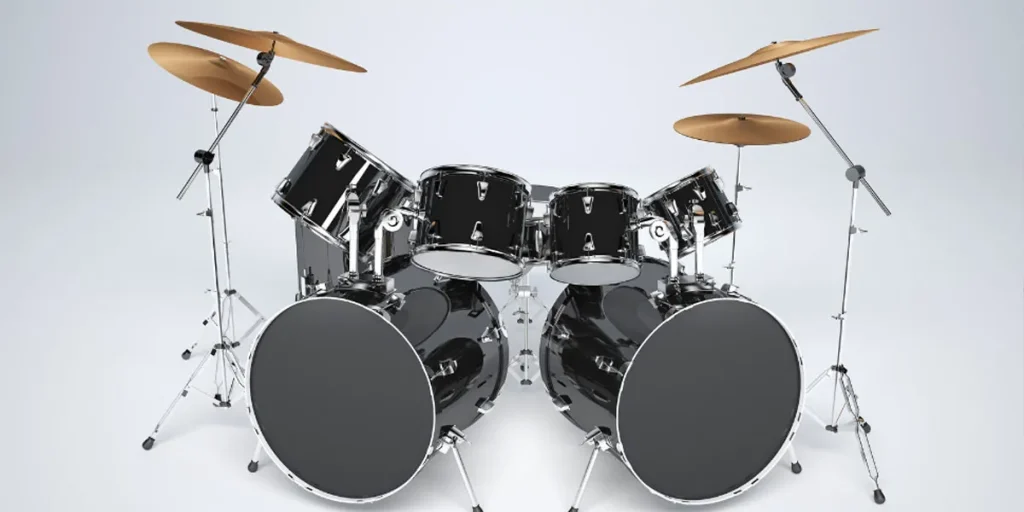A standard bass drum weighs between 14 to 26 pounds. The weight can vary based on size and materials used.
Selecting the right bass drum is a crucial decision for any drummer, influencing both the performance’s mobility and sound quality.
Professional musicians often prefer robust and heavier drums for the best sound output, while marching bands look for lighter options to ease transportation and playability on the move.
The weight of a bass drum impacts the setup time and energy required during gigs or rehearsals. Drums made of dense woods or with added metal hardware tend to be on the heavier side, providing deeper tones.
Conversely, using synthetic materials can reduce weight without greatly sacrificing sound.
It’s vital to balance the physical demands of handling the drum with the desired acoustic results, making the choice of a bass drum a strategic decision for the drummer or the band director.
Weights And Measures Of Bass Drums

The bass drum sets the foundation for the beat in any drum kit. Knowing its weight is key for transport and setup decisions.
Let’s dive into the typical weights and dimensions you can expect from these low-end powerhouses.
Standard Bass Drum Dimensions
Bass drums come in various sizes, influencing their weight. Standard sizes commonly utilized are:
- 18 inches in diameter – Ideal for jazz kits
- 20 to 22 inches – Versatile for rock and pop
- 24 inches or more – Favored for big, booming sound
Depth can also vary, typically between 14 and 24 inches, affecting weight and tone.
Impact Of Material On Weight
The material of a bass drum greatly impacts its weight. Common materials include:
| Material | Average Weight |
|---|---|
| Maple | Medium-heavy |
| Birch | Heavier |
| Mahogany | Lighter |
| Acrylic | Variable |
The hardware and fittings, such as metal hoops and mounts, add additional weight to consider.
Whether for studio sessions or live performances, gauging the weight of your bass drum ensures smooth handling in all your musical endeavors.
Factors Affecting A Bass Drum’s Weight

Drummers often ask, “How much does a bass drum weigh?” It’s vital because weight impacts transportation and setup.
Let’s discuss key factors that influence a bass drum’s weight. Understanding these can prepare you for the practicalities of owning and moving your drum set.
Shell Thickness
Bass drum shells come in various materials and thicknesses. Thicker shells generally mean more weight.
Wood like maple, birch, and mahogany are common, each with different weights:
- Maple – Heavy and sturdy, adds weight.
- Birch – Slightly lighter than maple, moderately heavy.
- Mahogany – Often found in vintage drums, can be heavy but varies.
More layers in the shell also add to the weight. Shells can range from 6-ply (lighter) to 10-ply (heavier).
Hardware Components
The weight of a bass drum isn’t just about the shell. Hardware plays a big role. This includes:
- Lugs and tension rods
- Tom mounts
- Spurs and legs
- Hoops and claws
Strong, durable hardware means more weight. Some use aluminum to reduce weight, while others favor brass or steel for robustness.
Size Variations
Size matters in bass drum weight. Here’s a simple guide:
| Drum Size | Typical Weight |
|---|---|
| 18 inches | Lightweight |
| 22 inches | Most common, moderate weight |
| 24 inches or larger | Heavy, for bigger sound |
A bigger drum means a bigger shell and more material. This increases the weight significantly.
Comparing Different Types Of Bass Drums
Drummers are often curious about the weight of their instruments. Weight affects portability and performance. Today, let’s explore the weights of different types of bass drums.
Marching Bass Drums Vs. Set Bass Drums
Marching bass drums are designed for mobility. Made with lighter materials, they allow the drummer to move with ease.
Set bass drums are part of a drum kit. They’re usually heavier, supporting a stable performance.
| Type of Drum | Average Weight |
|---|---|
| Marching Bass Drum | 14-26 lbs (6-12 kg) |
| Set Bass Drum | 22-40 lbs (10-18 kg) |
Weights can vary based on size and material. Common marching bass drum sizes range from 14″ to 32″. Set bass drums often come in sizes like 18″ to 24″.
Acoustic Vs. Electronic
Acoustic bass drums form the heart of a traditional drum set. They’re made with wood or metal shells. These drums weigh more.
They provide a deep, resonant tone. Electronic bass drums are lighter. They’re easier to transport. Their sound comes from digital samples.
- Acoustic Bass Drum: Deep sound, heavier build.
- Electronic Bass Drum: Lighter, compact, sound variety.
The weight of an acoustic bass drum can vary. Shell material and hardware affect the weight. Electronic drums might only weigh a few pounds.
Practical Considerations For Drummers
For drummers, considering the weight of a bass drum is crucial. It affects how you prepare for a gig or rehearsal.
It impacts your comfort and performance. In this section, we’ll explore two vital areas: transportation issues and ergonomics.
These will help drummers make informed decisions about their instruments.
Transportation Issues
Moving your bass drum from one venue to another can be a challenge. Weight and size must work for your vehicle.
Drums are not just heavy; they’re also awkward to handle. Here’s what you need to think about:
- Case Quality: Get a case that protects and eases carrying your drum.
- Venue Distance: Consider the walk you’ll do with your drum. Longer trips need wheels.
- Vehicle Space: Ensure your drum fits in your transport without a hassle.
Physical Limitations And Ergonomics
Your physical health is important. A heavy bass drum could strain your back or shoulders. Look at these points:
| Aspect | Details |
|---|---|
| Drum Weight | Choose a drum that balances sound quality and manageability. |
| Lift Technique | Use your legs, not your back. Keep the drum close to your body. |
| Physical Fitness | Building core strength helps manage weight and improves stability. |
| Hardware Selection | Opt for lightweight stands and pedal options where possible. |
Ergonomic setups reduce risks and increase comfort. Adjust your drum position. Keep it at a height that’s natural to play.
Use hardware to minimize the weight you carry. Protect your posture every time you play.
Innovations In Drum Manufacturing
The quest for the perfect bass drum sound often starts with its weight. In the world of drum manufacturing, innovations influence not only sound quality but also portability and convenience for drummers.
Lightweight Materials And Designs
Advancements in technology have revolutionized drum designs, making them lighter without sacrificing sound quality.
Modern bass drums now come in a range of weights, suiting various genres and transportation needs.
- Fiber composites offer durability and reduced weight.
- Designers use aluminum hardware for lighter drum kits.
- Acrylic shells provide a weight-efficient alternative with a unique aesthetic.
Customization Impact On Weight
Drummers crave instruments that reflect their style. Customization affects the overall weight of bass drums.
| Custom Feature | Weight Impact |
|---|---|
| Shell Thickness | Adds weight, enhances depth |
| Metal Hardware | Increases weight, adds support |
| Mounting Systems | Variable weight, improves versatility |
Selecting lighter woods or synthetic materials can counterbalance added custom features.
FAQ About the Weight of a Bass Drum
What Is The Average Weight Of A Bass Drum?
The average weight of a bass drum varies between 15 to 30 pounds. Factors such as the drum’s size, material, and hardware contribute to its weight.
Does Size Affect The Weight Of Bass Drums?
Yes, the size of a bass drum significantly influences its weight. Larger bass drums are heavier due to more materials used for their construction.
How Heavy Is A Marching Band Bass Drum?
A typical marching band bass drum can weigh from 20 to 40 pounds. The weight includes all the accessories needed to carry and play the drum.
Are Bass Drums Heavier Than Snare Drums?
Bass drums are generally heavier than snare drums. Snare drums usually weigh around 5 to 15 pounds, making them easier to carry and manage.
Conclusion
Understanding the weight of your bass drum is crucial, whether for transportation or technique refinement.
We’ve provided an insightful look into factors influencing drum weight. Make informed choices for your musical journey – every pound matters. Ready to rock? Ensure your gear matches your groove.
Resources:
https://www.britannica.com/summary/drum-musical-instrument
